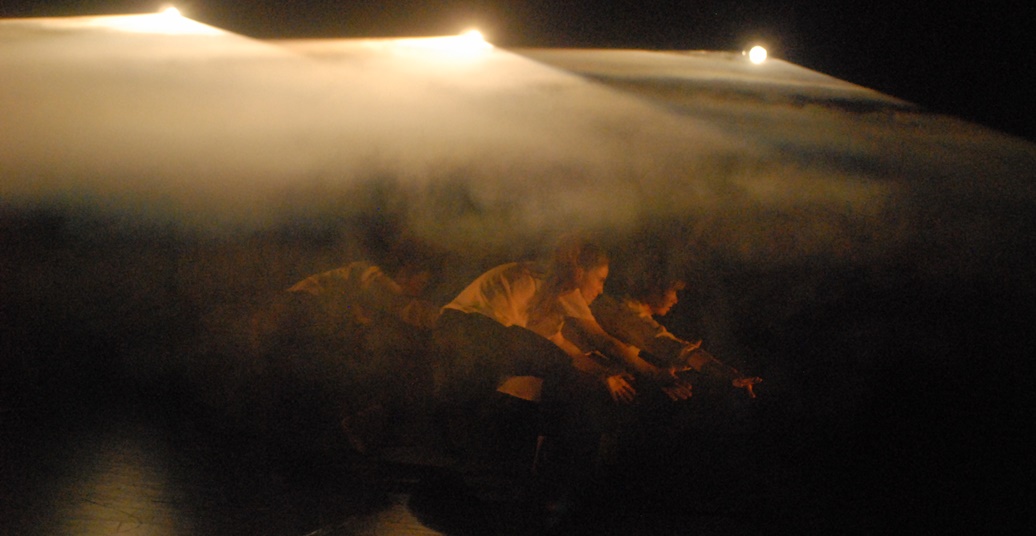The new work “A Millimeter in Light Years” by Potsdam’s own Laura Heinecke combines big questions, fog machines, and ensemble work at fabrik Potsdam.
Potsdam has a funny distance to Berlin. It is both a stone’s throw away, perched on the tip of the S-Bahn a mere thirty-eight minutes from Mitte, and yet of a totally different culture, demographic, cityscape, and atmosphere. Going to Potsdam feels like travelling, and going to see dance in Potsdam always feels equally distinct, too. Berlin is big enough to be its own bubble — and to have several healthy dance micro-bubbles within it. Potsdam, at a mere 170,000 citizens, has both an acutely cosy feel and yet, perhaps due to its small size, is often looking outward. fabrik Potsdam’s artistic directorship is always keen to support both local and international work, and at the yearly festivals artists from France, Korea, and Canada are presented as often as those from Potsdam and Berlin.
It thus is somehow fitting that a Potsdam-raised choreographer should not remain in the region, but experienceart abroad before returning home. Such indeed is the case of Laura Heinecke,who studied in Freiburg before moving to Brussels to learn, work, and create inthat bustling international scene. Heinecke returned to her hometown in 2012,establishing her own ensemble and joining the organizing team of PotsdamerTanztage for several years, but continues to connect to and create withartists from outside the Brandenburg region.
Heinecke’s new work, “A Millimeter in Light Years”, springs from an interest in the relationship between distance, personal freedom, and the practice of empathy, with a particular interest on what distance means in personal, cultural, and spatial terms. The piece begins with the entrance of a solo figure dressed in a sheer white blouse and green trousers, flicking, whirling, and unwinding her limbs with precision, before being joined by the ensemble in varying numbers. It is exciting to see six dancers on stage together in a new work, when one often sees at most three – and to really see them move. The group mostly appears in unison combinations, occasionally dividing into variations. Some of the group movement has force and power (like big reaches or spins on the knees by the entire ensemble), but much of the time the unison is not quite in unison, and thus the effect is severely splintered. Dynamic emphasis is also lacking, and relies heavily on the music to delineate the dramatic shape.
Stronger moments emerge in duets and in well-performed solos. A particularly interesting episode involves two duos dancing simultaneously in very distinct ways, which illustrates more than any other the motivating themes of personal and cultural distance and difference. The lone figure on which we focus during solos also enables us to clearly see the interfacing of the moving body with the soundscape and lighting.
Indeed, in her programme text, Heinecke writes about the integrative nature of the sound and light, created by Nicholas Schulze and Ralf Grueneberg, respectively. The first half took place on a brightly lit stage with light floors, dark walls, and five flat, square-shaped lights flickering overhead. In contrast, we arrive in the second half to a place of dimness and quiet. Before our eyes fully adjust, puffs of smoke come to us from the back corners of the stage, and beneath this gauze of fog we glimpse three figures making soft, barely perceptible movements. With dips of heads and hands through these clouds, the effect is something like tai chi through the mist, but it’s Heinecke’s insistence on this image that, slowly over time, transforms it into an enveloping atmosphere of tranquility, enchantment, patience, and a sense of the ancient. It’s incredibly beautiful.
From this new perspective, the rest of the second half unfolds. The ensemble merges and disassembles under a tumbling, stormy cloud of smoke; it shatters into fragments as the light slices the space into segments. Here Grueneberg’s creativity as a lighting designer is amply shown, as architectural spaces are carved out in the fog, which the dancers fill, fall behind, move through, and play with.
The themes of distance, personal freedom, and empathy are not always clear. It is interesting to think about the layers of personal, cultural, and spatial distance as transposed onto the figures I see come together and move apart on stage. Yet, as I watch, it seems to me that it would probably be equally interesting to think of similarly philosophical but unrelated themes (for example, gravity, or wisdom, or partnership, or transience) and ponder them through the lens of this work. Indeed “A Millimeter in Light Years” is very much a movement piece whose richness lies in it being strikingly anti-didactic and ephemeral. That, though, is not to take away from the company’s production, for dances need not be treatises. After all, Heinecke’s mix of lights, jumps, and ensemble work, with moments of pedestrian movement, gesture, and stillness, show us a glimpse of two different dance worlds combined. Brought to life by a cast hailing from Potsdam, Brussels, Tel Aviv and beyond, she provides us with much to reflect on as concerns all types of distance and the gifts each brings.




